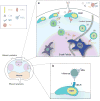Complement-dependent transport of antigen into B cell follicles
- PMID: 20724732
- PMCID: PMC3477863
- DOI: 10.4049/jimmunol.1000522
Complement-dependent transport of antigen into B cell follicles
Abstract
Since the original proposal by Fearon and Locksley (Fearon and Locksley. 1996. Science 272: 50-53) that the complement system linked innate and adaptive immunity, there has been a rapid expansion of studies on this topic. With the advance of intravital imaging, a number of recent papers revealed an additional novel pathway in which complement C3 and its receptors enhance humoral immunity through delivery of Ag to the B cell compartment. In this review, we discuss this pathway and highlight several novel exceptions recently found with a model influenza vaccine, such as mannose-binding lectin opsonization of influenza and uptake by macrophages, and the capture of virus by dendritic cells residing in the medullary compartment of peripheral lymph nodes.
Figures




Similar articles
-
Complement-Opsonized Nano-Carriers Are Bound by Dendritic Cells (DC) via Complement Receptor (CR)3, and by B Cell Subpopulations via CR-1/2, and Affect the Activation of DC and B-1 Cells.Int J Mol Sci. 2021 Mar 11;22(6):2869. doi: 10.3390/ijms22062869. Int J Mol Sci. 2021. PMID: 33799879 Free PMC article.
-
Capture of influenza by medullary dendritic cells via SIGN-R1 is essential for humoral immunity in draining lymph nodes.Nat Immunol. 2010 May;11(5):427-34. doi: 10.1038/ni.1856. Epub 2010 Mar 21. Nat Immunol. 2010. PMID: 20305659 Free PMC article.
-
Adaptive immune responses are dispensable for isolated lymphoid follicle formation: antigen-naive, lymphotoxin-sufficient B lymphocytes drive the formation of mature isolated lymphoid follicles.J Immunol. 2005 May 1;174(9):5720-8. doi: 10.4049/jimmunol.174.9.5720. J Immunol. 2005. PMID: 15843574
-
Follicular dendritic cells in germinal center reactions.Adv Exp Med Biol. 1993;329:461-5. doi: 10.1007/978-1-4615-2930-9_77. Adv Exp Med Biol. 1993. PMID: 8379410 Review. No abstract available.
-
Human marginal zone B cells.Annu Rev Immunol. 2009;27:267-85. doi: 10.1146/annurev.immunol.021908.132607. Annu Rev Immunol. 2009. PMID: 19302041 Review.
Cited by
-
Material design for lymph node drug delivery.Nat Rev Mater. 2019 Jun;4(6):415-428. doi: 10.1038/s41578-019-0110-7. Epub 2019 May 2. Nat Rev Mater. 2019. PMID: 32523780 Free PMC article.
-
DNA origami vaccines program antigen-focused germinal centers.bioRxiv [Preprint]. 2025 Mar 1:2025.02.21.639354. doi: 10.1101/2025.02.21.639354. bioRxiv. 2025. PMID: 40060683 Free PMC article. Preprint.
-
Technological approaches to streamline vaccination schedules, progressing towards single-dose vaccines.NPJ Vaccines. 2020 Sep 18;5:88. doi: 10.1038/s41541-020-00238-8. eCollection 2020. NPJ Vaccines. 2020. PMID: 33024579 Free PMC article. Review.
-
Beyond binding: antibody effector functions in infectious diseases.Nat Rev Immunol. 2018 Jan;18(1):46-61. doi: 10.1038/nri.2017.106. Epub 2017 Oct 24. Nat Rev Immunol. 2018. PMID: 29063907 Free PMC article. Review.
-
CD23+ CD21(high) CD1d(high) B cells in inflamed lymph nodes are a locally differentiated population with increased antigen capture and activation potential.J Immunol. 2012 Jun 15;188(12):5944-53. doi: 10.4049/jimmunol.1103071. Epub 2012 May 16. J Immunol. 2012. PMID: 22593620 Free PMC article.
References
-
- Fearon DT, Locksley RM. The instructive role of innate immunity in the acquired immune response. Science. 1996;272:50–54. - PubMed
-
- von Andrian UH, Mempel TR. Homing and cellular traffic in lymph nodes. Nat Rev Immunol. 2003;3:867–878. - PubMed
-
- Mempel TR, Junt T, von Andrian UH. Rulers over randomness: stroma cells guide lymphocyte migration in lymph nodes. Immunity. 2006;25:867–869. - PubMed
Publication types
MeSH terms
Substances
Grants and funding
LinkOut - more resources
Full Text Sources
Miscellaneous

